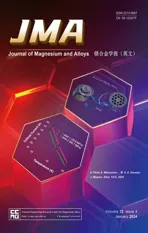The corrosion characteristic and mechanism of Mg-5Y-1.5Nd-xZn-0.5Zr(x=0,2,4,6 wt.%) alloys in marine atmospheric environment
2024-04-18QuantongJiangDongzhuLuLirenChengNazhenLiuBaorongHou
Quantong Jiang ,Dongzhu Lu ,Liren Cheng ,Nazhen Liu ,Baorong Hou,d
aCAS Key Laboratory of Marine Environmental Corrosion and Bio-fouling, Institute of Oceanology, Chinese Academy of Sciences, No. 7 Nanhai Road,Qingdao 266071, PR China
b State Key laboratory of Rare Earth Resource Utilization, Changchun Institute of Applied Chemistry, Chinese Academy of Sciences, No. 5625 Renmin Street,Changchun 130022, PR China
c Open Studio for Marine Corrosion and Protection, Pilot National Laboratory for Marine Science and Technology (Qingdao), No. 1 Wenhai Road, Qingdao 266071, PR China
d Sanya Institute of Oceanology, South China Sea Institute of Oceanology, Chinese Academy of Sciences, Zhenzhou Road, Sanya 572000, PR China
Abstract The microstructure and precipitated phases of as-cast Mg-5Y-1.5Nd-xZn-0.5Zr (x=0,2,4,6 wt.%) alloys were investigated by optical microscopy,scanning electron microscopy,energy-dispersive spectrometry and X-ray Diffraction.The exposure corrosion experiment of these magnesium alloys was tested in South China Sea and KEXUE vessel atmospheric environment.The corrosion characteristic and mechanism of magnesium alloys of Mg-5Y-1.5Nd-xZn-0.5Zr (x=0,2,4,6 wt.%) alloys were analyzed by weight loss rate,corrosion depth,corrosion products and corrosion morphologies.The electrochemical corrosion tests were also measured in the natural seawater.The comprehensive results showed that Mg-5Y-1.5Nd-4Zn-0.5Zr magnesium alloy existed the best corrosion resistance whether in the marine atmospheric environment and natural seawater environment.That depended on the microstructure,type and distribution of precipitated phases in Mg-5Y-1.5Nd-4Zn-0.5Zr magnesium alloy.Sufficient quantity anodic precipitated phases in the microstructure of Mg-5Y-1.5Nd-4Zn-0.5Zr alloy played the key role in the corrosion resistance.
Keywords: Marine atmospheric environment;Exposure corrosion;Magnesium alloy;Corrosion rate;Corrosion mechanism.
1.Introduction
Magnesium alloys have the excellent mechanical strength,creep resistance,damping performance and heat-conducting property [1–3],which have been widely used in the transportation,weapons,aerospace fields,and so on [4–6].However,because the chemical properties of magnesium lively,the corrosion potential of magnesium and its alloys very low(-2.36 V),it is very easy prone to severe corrosion [7–8].
Improving the corrosion resistance of Mg alloys through a change in their chemical composition,phase constituent and distribution and/or other micro-structural characteristics is the most reliable and trouble-free corrosion mitigation approach[9].Alloying was regarded as an effective approach in improving the corrosion resistance of magnesium alloys [10].An ideal design can ensure that a Mg alloy in the given service environment has the lowest thermodynamic possibility and the highest corrosion kinetic resistance.Alloying addition with rare earth (RE) elements is an effective approach to enhancing strength as well as tailoring texture [11].Many studies have been reported that adding the RE element of Gd,Y,Nd into pure Mg can greatly enhance strength through precipitation strengthening and weaken basal texture during hot deformation [12–14].Neodymium is the common alloying element for magnesium alloy,which can improve the mechanical strength by refining grain ofα-Mg [15].With the addition of Nd to the magnesium alloys,creep resistance and fatigue performance also both have an effective improvement in the room temperature and high temperature conditions[16].Moreover,Neodymium element can improve the corrosion resistance of magnesium alloys [17].Therefore,the corrosion behavior of magnesium alloys contained Neodymium contents have been studied by many researchers in the recent years.Birbilis et al.[18]researched the corrosion resistance of Mg–La,Mg–Ce and Mg–Nd binary alloys,and found that additions of RE-contents resulted an enlargement of corrosion rate.Mirza et al.[19]studied the microstructure and performance of Mg–Nd–Zn–Zr alloy,and they found that the uniform and stable Mg12Nd precipitated phases partly improved corrosion resistance because of grain refinement mechanism.Williams et al.[20]studied the addition from 0.47 to 3.53 wt.% of Nd element in the magnesium alloys,and they drew a conclusion that Nd-rich area occurred the cathodic activation,which led to a serious localized corrosion on the surface of Mg–Nd alloys.Zucchi et al.[21]used electrochemical tests to analyzed the corrosion behavior of WE43 magnesium alloy.They found that the Yttrium and Neodymium elements caused the improvement of Mg anode activity.Jiang et al.[22–24]explored the dual role of precipitated phases in Mg–Y–Nd ternary alloys system,which mainly depended on their distribution and type.The weight loss rate and electrochemical corrosion were also analyzed in Mg–Y–Nd ternary alloys system.Ma et al.[25]researched the precipitated phases and corrosion resistance of Mg–5Y–1.5Nd alloy after heat treatment,and obtained the conclusion that micro-galvanic reaction between cathodic and anodic had been changed by solution and age heat treatment.
Zn element plays an effective role in solid solution strengthening and precipitation hardening,and it generally improves the fluidity of Mg alloy [26–28].Considering the unique role of Zn with RE elements,Fu et al.[29]modified the Mg–Gd–Zn–Zr alloy by Zn addition,leading to improved mechanical properties.Their optical microscope observations clearly showed the LPS phases precipitated along the grain boundaries,whose volume fraction increases with increasing the amount of the Zn additions.The notable feature of the alloys is that the elongation is substantially improved with increasing the amount of the Zn additions at the expense of strength.It has also been reported that the strengthening effect of a small addition of zinc is significant in dilute Mg–Y solid solution alloys [30].Therefore,zinc is a potential candidate for reducing yttrium content without sacrificing useful creep strength of Mg-Y alloys.The strengthening mechanism of zinc in Mg–Y alloys,however,has not been clarified yet.Zinc is present in AZ91 to improve room temperature strength.It also helps overcome the harmful corrosive effect of iron and nickel impurities that might be present in the alloy[30].Rare earths (RE) have been used in magnesium alloys for many years usually as misch metal(MM).Some investigations have been done on the precipitation,morphology,structure and thermal stability of intermetallic phases.Wang et al.[31]reported that the addition of 0.5 wt.%Zn results in ∼30%reduction in grain size for Mg–2Al–0.5Mn alloys.Moreover,the results of Liu et al.[32]imply that the grain refinement effect of Zn continues up to 2 wt.%.As a result,the addition of higher amount of Zn is not beneficial.Zn is generally regarded as a favorable alloying element for enhancing strength by increasing age hardening response,producing intermetallic compounds,and refining grain size [33,34].In the past decade,Mg–RE–Zn alloy systems have attracted substantial attention,due to solution strengthening,aging strengthening,and long period stacking order (LPSO) structures strengthening [35–38].However,most of these mainly focus on mechanical property,and there are rare studies involved in the corrosion resistance in the actual serve environment [39].
The main service environment of magnesium structural materials is the atmospheric environment.Environmental parameters are as important to corrosion as the composition and microstructure of magnesium alloys.With the rapid development of ocean exploration in the world,magnesium structural materials are gradually served in typical marine environment.In the marine atmospheric environment,the problem of electrochemical corrosion of magnesium alloys is very prominent due to the activity of magnesium element.
The South China Sea is the tropical marine corrosion environment,the average annual temperature is around 28 °C,while the mean annual precipitation is more than 2800 mm.The corrosion of magnesium alloys occurs easily in the south China Sea environment because of the specific high temperature,high humidity,high sea salts and high ultraviolet radiation.Corrosion leads to the failure of materials and structures,which causing the large economic loss.Therefore,a major research issue of magnesium alloys is their corrosion behavior in this typical marine atmospheric environment.
In this work,the corrosion behavior of Mg-5Y-1.5Nd-xZn-0.5Zr (x=0,2,4,6 wt.%) magnesium alloys in the harsh South China Sea environment was researched.The corrosion resistance of different alloys was also analyzed via weight loss rate and electrochemical measurement in the laboratory.Mg-5Y-1.5Nd-xZn-0.5Zr magnesium alloy existed the best corrosion resistance which depended on the microstructure,type and distribution of precipitated phases.The microstructure of alloys was investigated in order to explain corrosion mechanism.The need and the requirement of materials corrosion testing in the marine environment was analyzed from the aspects of the ocean exploited and military applications.
2.Experimental
2.1. Material preparation and characterization
In this study,the different Mg–Y–Nd–Zn–Zr alloys were smelted in the medium frequency induction heating furnace.Mg (>99.95%),Y (>99.99%),Nd (>99.99%) and Zn(>99.99%) elements were added by pure metal,whereas Zr element was added by Mg-30Zr (>99.99%) intermediate alloy.The nominal compositions of the alloys were Mg-5Y-1.5Nd-xZn-0.5Zr (x=0,2,4,6 wt.%).Before smelting,the heating furnace was strictly cleaned and dried.Pure magnesium ingots were preheated at 200 °C for 30 min.And then the magnesium ingots were put into the heating furnace,heated and smelted.In order to prevent pure magnesium from reacting with air during the smelting process,protective agents (RJ-2) were added into the melt.MgC12in the protective agents could react with Y and Nd elements,which affected the yield of alloy-elements.Therefore,the addition of Y and Nd elements should be more than the nominal composition [40].
When the melting temperature reached to 750 °C,Y(>99.99%) and Nd (>99.99%) metals were added.In order to melt the rare earths quickly,they were broken into small pieces before addition.The melts were continue to heat to 820 °C,and hold the temperature for 30 min.After the rare earth metals were completely melted,the first mechanical stirring was carried out.The dross should be taken out in time during the stirring process.Then the preheated Mg-30Zr master alloys were added into the melt and hold the temperature for 20 min,followed by the second mechanical stirring to remove the dross.
The magnesium alloy melt would form the deep shrinkage cavity in the solidification process due to the high temperature,so the cooling must be carried out before casting.When the temperature dropped to 720 °C,the third mechanical stirring was carried out to remove the scum.Then the melt poured and casted into the metal mold,which had been preheated at 250 °C for a long time.The density of rare earths was larger than that of pure magnesium.Therefore,the mold was placed in to a water vessel to avoid the gravity segregation in solidification process.The ingot was turned to remove the skin and riser after demolding.The alloy powders in the middle of the ingot were taken to test the elemental content determination by ICP-AES.The results were shown in Table 1.

Table 1 Compositions of Mg-5Y-1.5Nd-xZn-0.5Zr alloys detected by ICP-AES.
The samples for optical microscope (OM) and scanning electron microscope (SEM) observation were polished with metallographic sandpaper from 800# to 5000# successively.And then the polishing pasted (1.0 pm) were used to burnish the surfaces of magnesium alloys.The surfaces were washed with deionized water and ethanol.The microstructure of surface was etched by immersing in 4% acetic alcohol for 10 s.The surfaces were washed with deionized water and ethanol.Finally,the surfaces of samples were dried by cold air.
The microstructure and precipitated phases were measured by OM(CarlZeiss Axiovet 2000MAT),SEM(JSF-6700F)and EDS (INCA).The characteristic peaks of precipitated phases and Mg-matrix in Mg-5Y-1.5Nd-xZn-0.5Zr alloys were tested by XRD (D/Max 2550) with the diffraction angles from 10°to 90° The scanning step was at 4°/min with Cu-target.The voltage and current were 40 kV and 40 mA,respectively.
JEM-2000 transmission electron microscope equipped with EDS was used to observe and analyze the phases morphologies and composition.The preparation of TEM samples was as follows: Samples were cut into 1 mm thickness sheets.And then the sheets were grinded to 100μm thickness under water-cooling condition.Some wafers (Φ=3 mm) were cut down from the sheets,which were grinded to 50–60μm thickness under ethanol-cooling condition.The wafers were thinned by a twin-jet electropolishing device (MTP-1A) with 5% ethanol perchlorate solution.The twin-jet electropolishing temperature was at-30°C,and the voltage of the device was set at 20 V.The ion thinning was carried out by the device(Gatan Pips691) before observation in order to remove the oxide film on the sample surface.The ion thinning temperature was at -170 °C,and the vacuum degree of the device was set at 10-3.
2.2. Exposure tests in south China sea environment
The Mg-5Y-1.5Nd-xZn-0.5Zr (x=0,2,4,6 wt.%) alloys were used to atmospheric exposure experiment in the South China Sea environment (Fig.1a and b).The size of samples was 5 cm×5 cm×0.5 cm.The mechanical strength samples were processed according to ISO6892-1:2009.The threaded parts were prevented with polytetrafluoroethylene tape from corrosion.The fracture sites must locate within the standard distance in order to obtain the valid data during the process of tensile tests.
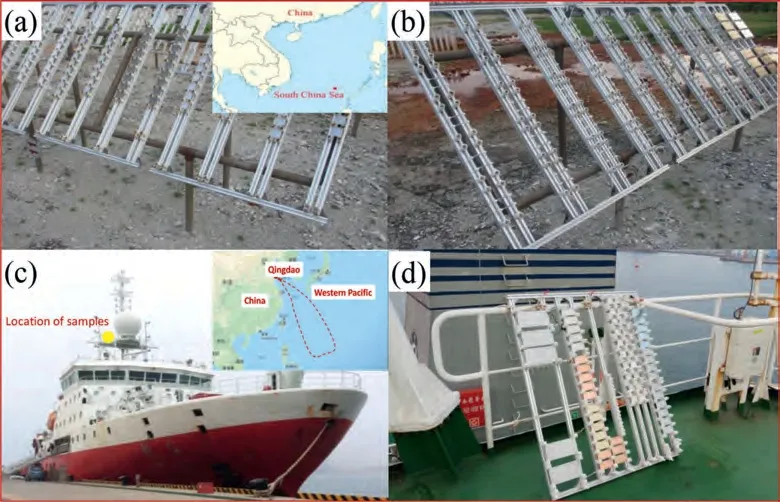
Fig.1.The photographs of different corrosion samples in South China Sea exposure site (a&b) and KEXUE vessel exposure site (c&d).
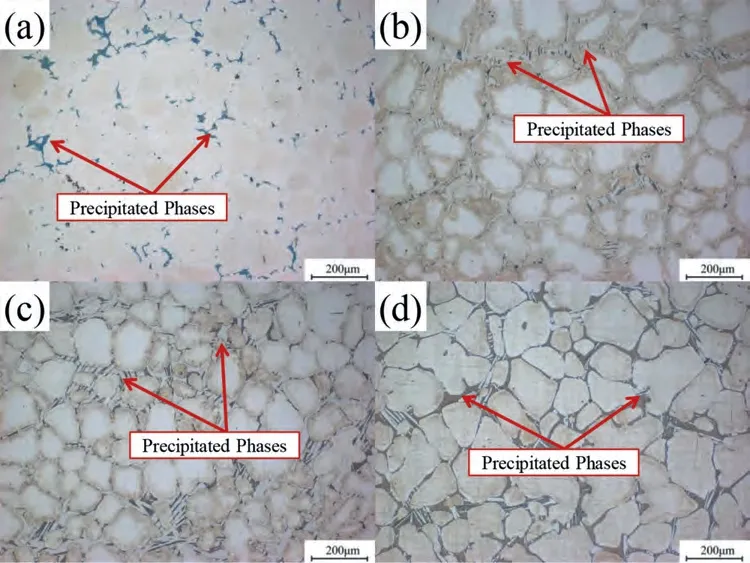
Fig.2.The optical photographs of microstructure for Mg-5Y-1.5Nd-xZn-0.5Zr (x=0,2,4,6 wt.%) alloys.
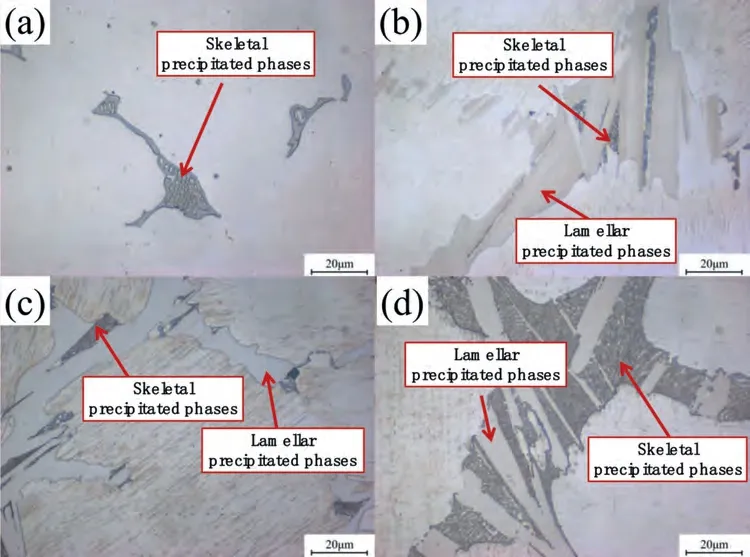
Fig.3.The magnifying optical photographs of microstructure for Mg-5Y-1.5Nd-xZn-0.5Zr (x=0,2,4,6 wt.%) alloys.
The site of exposure corrosion was at South China Sea,which belong to Institute of Oceanology,Chinese Academy of Sciences.The corrosion test site has a tropical maritime monsoon climate.The northeast monsoon prevails from October to March of next year,whereas the southwest monsoon prevails from May to September in the exposure environment.There are only two seasons in a year.From December to May of the next year is the dry season with little rain.And the rest time is the wet season.The corrosion site was in a high temperature,high humidity,high salts and high solar radiation environment all the year round.
2.3. Exposure tests in the KEXUE vessel environment
The exposure corrosion experiments of Mg-5Y-1.5Nd-xZn-0.5Zr (x=0,2,4,6 wt.%) magnesium alloys were carried out on theKEXUEvessel during the open ocean expedition from May 14th 2019 to July 17th 2019 (Fig.1c and d).The size of the samples was 5 cm×5 cm×5 mm.TheKEXUEvessel is one of the national major science and technology infrastructures to undertake multi-disciplinary ocean research.The ship was designed by Marine Design&Research Institute of China,and built by Wuchang Shipbuilding Industry Co.,Ltd,which was delivered in 2012 and is operated by the Institute of Oceanology,Chinese Academy of Sciences.
During this exposure experiments,theKEXUEsailed from Qingdao,and the voyage was around the western pacific,finally the vessel returned to Qingdao.The marine atmospheric environment of this western pacific voyage was at the high temperature,high humidity,highly-saline and intense ultraviolet radiation.During the voyage,the samples of magnesium alloys often were splashed by the nearby ocean waves due to the strong wind.
2.4. Electrochemical corrosion and skpfm tests
Mg-5Y-1.5Nd-xZn-0.5Zr (x=0,2,4,6 wt.%) samples were polished with 800#∼5000# SiC sandpaper and polishing machine,and then cleaned with deionized water and ethanol.The working area of electrochemical tests was 1 cm2.Each alloy had three parallel samples to ensure repeatability.In this study,Princeton P4000+electrochemical workstation was used to measure samples in natural seawater.The auxiliary electrode was platinum wire,whereas the reference electrode was saturated calomel (SCE) reference electrode.The composition of natural seawater in this study was consistent with the previous study [39].
Firstly,the samples were immersed in the natural seawater to test the open-circuit potential (OCP) for 1800 s after they were stabilized.The electrochemical impedance spectroscopy(EIS) test was performed at the self-corrosion potential of the samples.The test frequencies ranged from 100 kHz to 10 mHz with an AC perturbation amplitude of ±5 mV.After the open circuit potential was stable,the polarization curve tests were carried out.The scanning of polarization curve started from the self-corrosion potential with a speed of 0.333 mV·s-1.The cathode polarization branches and anode polarization branches were scanned separately.The software Origin7.5 was used for data analysis.
The relative potential difference between precipitated phases and Mg matrix was tested by the scanning kelvin probe force microscope (SKPFM,MFP-3D Origin,OXFORD INSTRUMENTS).Before the SKPFM measurement,all the samples were polished by the abrasive paper (800#∼5000#)and polishing cloth,and then cleaned with ethanol.The experiment was carried out at 25°C and RH40%in the atmospheric condition.
2.4. Analysis and characterization of corrosion tests
In this study,digital camera was used to record the samples in situ macro morphologies with corrosion products.The corrosion products of the front surfaces were qualitatively analyzed by X-ray diffraction analysis (D/Max 2550).The scanning range was ranged from 10° to 90° with the Cu target.The scanning voltage and current were 40 kV and 40 mA,respectively.The scanning speed was 1°/min.
And then the weight loss rate was analyzed.Firstly,the loose corrosion products on the sample surface were removed with the brush,deionized water and boiled solution (200 g/L CrO3+10 g/L AgNO3) in turn [41].After pickling,the samples were successively cleaned with deionized water and ethanol.Finally,the samples were dried and weighed.
After the exposure corrosion tests,corrosion depths on the surfaces of different samples were measured by the thickness gauge (Instrument type: GTS8102).The thickness gauge needs to be calibrated using the standard alloys without corrosion.Each corrosion samples tested five different locations on the surfaces of magnesium alloys.All the testing surfaces selected the frontal sides,which corroded more seriously than the reverse sides because of the rain and ultraviolet radiation.
The surfaces of magnesium alloys were damaged after corrosion,resulting in a large number of corrosion pits.It was difficult to measure the actual cross-sectional area of the tensile samples.Therefore,the residual mechanical strength of magnesium alloys referred to the apparent strength.The residual mechanical strength at room temperature was tested by the MTS-810 universal testing machine.The tensile rate was 2 mm/min.Five parallel samples were tested in each magnesium alloys.The average value of five parallel samples was used as the final mechanical property.
3.Results and discussion
3.1. Microstructure of Mg-5Y-1.5Nd-xZn-Zr alloys
As shown in the Figs.2 and 3,the microstructure of different alloys was all composed ofα-Mg and precipitated phases.The precipitated phases of Mg-5Y-1.5Nd-0.5Zr alloy were dispersed on the grain boundaries,and the grain size was about 100μm.With the addition of 2 wt.% Zn metals,grain boundaries of magnesium alloys were more clearly visible.Eutectic structure could be seen obviously on grain boundaries,which presented a discontinuous distribution.With the increasing of Zn-content in the magnesium alloys,the volume fraction of eutectic microstructure on grain boundaries became larger.But the grain size barely changed significantly.When Zn-content reached to 4 wt.% in the magnesium alloys,the volume fraction of eutectic precipitated phases continued to increase and distribute on grain boundaries more and more.
When Zn-content increased to 6 wt.% in the magnesium alloys,the microstructure difference of Mg-5Y-1.5Nd-6Zn-0.5Zr alloy occurred obviously.The eutectic microstructure changed from the single eutectic form to the mixed eutectic.The precipitated phases appeared to the separated eutectic and lamellar eutectic,which were continuously distributed on the grain boundary.The morphologies of the eutectic precipitated phases were bulky.However,the grain size of four different magnesium alloys was nearly the same,although different Zncontent were added in the composition.With the change of Zn-content in magnesium alloy,the volume fraction and distribution of eutectic precipitated phases on the grain boundaries for different magnesium alloys showed the same variation tendency.The Image Pro-Plus 6.0 software was used to calculate the volume fraction of the precipitated phases.The statistical results were as follows: (A)=3.67%;(b)=11.26%;(c)=19.78%;(d)=26.85%.However,the grain size had no obvious change,which was about 100μm.The reason may be attributed to the addition of Zr-content in the magnesium alloys.During the solidification of melt,α-Zr particles precipitated firstly [42].And thenα-Zr particles were coated by theα-Mg.The lattice constants ofα-Zr element were accord with those ofα-Mg,resulted thatα-Zr particles were used as the nucleation ofα-Mg crystal core [43].Therefore,the grain size of magnesium alloys had been greatly decreased.In addition,rare earths can refine the grain size.The addition of 5 wt.% Y-content and 1.5 wt.% Nd-content also played an important effect on refining the microstructure of the magnesium alloys,which resulted that the grain size had no obvious change [44].
As shown in Fig.4,the morphologies and compositions of precipitated phases were also analyzed by SEM-EDS.When the Zn-content increased to 2 wt.%,the microstructure was composed of equiaxedα-Mg matrix and discontinuous reticular eutectic structure at grain boundaries,which was different from the microstructure of magnesium alloy with Zncontent.From the amplifying SEM photographs,the eutectic microstructure at grain boundaries was skeleton-like.And there were many blocky phases at the boundaries.In theα-Mg matrix,there were many needle-like precipitated phases distributed in parallel near the grain boundary.These needle-like phases extended from blocky phases at the grain boundary to the interior of the grain.With the Zn-content increased,the number of needle-like phases increased and extended from the massive LPSO phases [45–47].But the orientation of these needle-like phases was different in adjacent grains.According to previous research,needle-like phases were the LPSO structure [48].
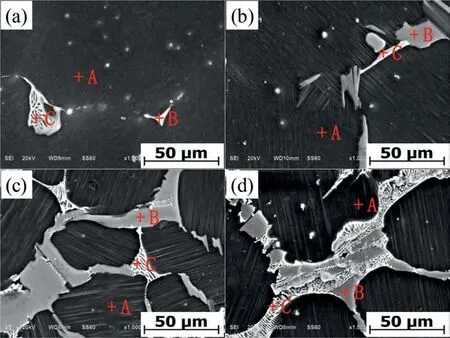
Fig.4.The magnifying SEM and EDS analysis for Mg-5Y-1.5Nd-xZn-0.5Zr (x=0,2,4,6 wt.%) alloys.
The EDS results were contained in the Table 2.Different morphologies of phases contained the different elements composition.The blank matrix locations (marked “A”) in Mg-5Y-1.5Nd-xZn-0.5Zr (x=0,2,4,6 wt.%) alloys mainly were contained magnesium element,and only very little yttrium,neodymium and zinc elements existed.In the Mg-5Y-1.5Nd-0.5Zr alloy,the chemical composition of precipitated phases were mainly arranged to be Mg24RE5and Mg12RE.With the addition of Zn-content,the ratio of Zn element in eutectic phases increased gradually.The amount of Zn-content was larger in the grain boundary due to the formation of Mg12REZn phases (marked “B”) in the non-equilibrium solidification process according to precipitation sequence system [49].And the atomic ratio of Zn/(Y,Nd) was about 1,which indicated that the microstructure of these phases existed as the LPSO formation [50].When the Zn-content equaled to 6 wt.%,the chemical composition of precipitated phases(marked “C”) changed from (Mg,Zn)4RE to (Mg,Zn)5RE.The amount of Nd-content in the precipitated phases (marked“C”) was larger than that of nominal component of the Mg-5Y-1.5Nd-xZn-0.5Zr (x=2,4,6 wt.%) alloys.This phenomenon indicated that Nd element was concentrated at the grain boundary to form of second phases during the nonequilibrium solidification [51].However,the Zr-content was nearly not detected.This phenomenon was because that Zr element could not react with Mg element and existed in a free form [52].
The XRD analysis for Mg-5Y-1.5Nd-xZn-0.5Zr (x=0,2,4,6 wt.%) alloys were shown in Fig.5.The composition of Mg-5Y-1.5Nd-0.5Zr alloys consisted ofα-Mg,Mg24Y5and Mg12Nd phases.These were all conventional precipitates in Mg-Y-Nd alloy system.Zr element is usually present in a free state in magnesium matrix.The amount of Zrcontent was very little,which was not detected by the XRD.With the addition of Zn-content,the types and quantities of phases in the magnesium alloys had altered.The diffraction peaks of Mg12YZn phases appeared,whereas the intensity of Mg24Y5diffraction peaks decreased.This is because a large amount of Y-content involved in the formation of Mg12YZn phases.According to the previous studies,the microstructure of Mg12YZn phases long period stacking orderly [53].Furthermore,the intensity of Mg12Nd diffraction peaks barely changed.
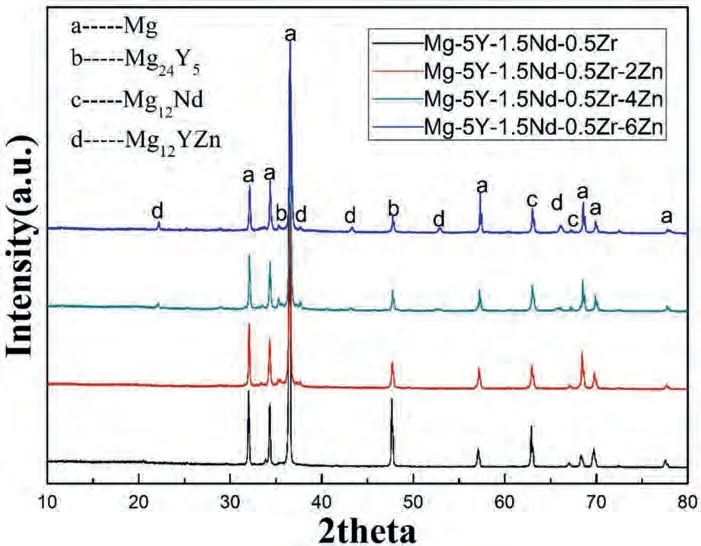
Fig.5.The XRD analysis for Mg-5Y-1.5Nd-xZn-0.5Zr (x=0,2,4,6 wt.%) alloys.
The bright field images of TEM and SAED were shown in the Fig.6.The TEM and SEAD of precipitated phase in Mg-5Y-1.5Nd-0.5Zr alloy was shown in Fig.6(a).The microstructure of the location area was body centered cubic.Combined with the SEM-EDS and XRD results in the Figs.4 and 5,it can be concluded that the main component of precipitated phase was Mg24RE5phase,which lattice parameter wasa=1.13 nm.With the addition of Zinc-content,the microstructure was composed ofα-Mg matrix,eutectic precipitated phases and linear phases near grain boundary,and the linear structure near grain boundaries increased with the increasing of Zn-content.Another massive LPSO phases were found in grain boundaries,which were different from the eutectic structures.As shown in Fig.6(b),when Zn-content was 2 wt.%,the crystal structure of Mg12RE phase was tetragonal 14/M tetragonal,and the lattice parameter werea=1.03 nm andc=0.59 nm,respectively.As shown in Fig.6(c) and(d),the Zn-content increasing to 4 wt.% and 6 wt.%,and the zone axis was parallel to respectively [01–10]αand [2–1–10]α.The precipitated phases Mg12ZnRE were formed in the tabular structure near the grain boundaries.There were 13 secondary electron diffraction spots evenly distributed between transmission spot(0000)αand diffraction spot(0002)α.The distance between (0000)αand diffraction spot (0002)αwas 14 equal.It can be seen that the precipitated phases belonged to ABABCACACACBABA,which were ordered to be 14H-LPSO structure [54].
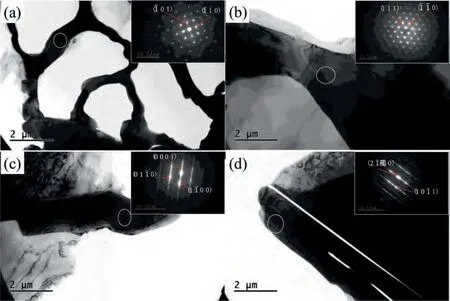
Fig.6.The TEM and SEAD analysis for Mg-5Y-1.5Nd-xZn-0.5Zr (x=0,2,4,6 wt.%) alloys.
3.2. Corrosion in south China sea atmospheric environment
The corrosion products on the surface of Mg-5Y-1.5NdxZn-0.5Zr(x=0,2,4,6 wt.%)magnesium alloys showed obvious dark brown after exposure corrosion for a certain period in South China Sea atmospheric environment in Fig.7.The color of corrosion products was different from the common white corrosion products,such as MgCl2,Mg(OH)2,MgCO3,or other magnesium carbonate hydroxides.The location of thread for the tensile samples basically retained fresh without corrosion due to the protection of polytetrafluoroethylene.Corrosion products only appeared in the gauge length.It was observed that all the corrosion products were relatively compact.The formation of corrosion products on the surface of magnesium alloy might protect theα-Mg matrix from a further corrosion to a certain extent.
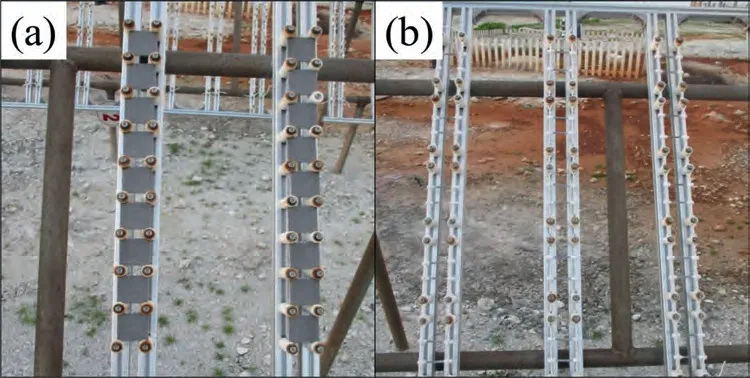
Fig.7.The photographs of exposure corrosion test of Mg-5Y-1.5Nd-xZn-0.5Zr (x=0,2,4,6 wt.%) alloys in South China Sea site.
As shown in Tables 3 and 4,Mg-5Y-1.5Nd-4Zn-0.5Zr alloy had the lowest average corrosion rates 0.0224 g·cm-2·y-1,whereas the Mg-5Y-1.5Nd-6Zn-0.5Zr showed the largest corrosion rates 0.0782 g·cm-2·y-1.This phenomenon may be attributed to the amount and distribution of the precipitated phases.Actually,the precipitated phases in the magnesium alloys often have a more positive potential than theα-Mg matrix,and then they act as the cathode of the microelectrochemical reaction in the microstructure.However,there are some anodic precipitated phases with the higher activity thanα-Mg matrix in the Mg-RE alloys [55].The grain size of Mg-5Y-1.5Nd-xZn-0.5Zr alloys with different zinc-content were very similar,which illustrated that grain size did not play the crucial role in the difference of corrosion resistance for Mg-5Y-1.5Nd-xZn-0.5Zr alloys.In the present study,the order of weight loss rate is as follows: Mg-5Y-1.5Nd-4Zn-0.5Zr Table 3 The weight loss rate of Mg-5Y-1.5Nd-xZn-0.5Zr (x=0,2,4,6 wt.%) alloys after 2 years exposed corrsion in South China Sea site. Table 4 The corrosion depth of Mg-5Y-1.5Nd-xZn-0.5Zr (x=0,2,4,6 wt.%) alloys after 2 years exposed corrsion in South China Sea site. According to our previous research [39],the quantitative relationship between the weight loss rates (△W) and corrosion depthsPW(mm·y-1) can be calculated by the formula:PW≈k△W.k is a constant value in laboratory experiments.However,k represents a coefficient,which decrease with the increasing of corrosion rates for exposure tests in marine atmospheric environment.In this study,the quantitative relationship between the weight loss rates and corrosion depths was also calculated in Fig.8.The quantitative relationship of Mg-5Y-1.5Nd-xZn-0.5Zr (x=0,2,4,6 wt.%) magnesium alloys samples was respectivelyPW≈1.93 △W,PW≈2.21△W,PW≈2.43 △W,andPW≈1.53 △W.For one particular magnesium alloy,the weight loss rate and corrosion depth are mainly affected by temperature and chloride ion concentration during immersion test in the laboratory.Environmental factors are relatively stable,therefore the coefficient k can be a constant value.However,the k value will be affected by the corrosion rate in marine atmospheric exposure test,which is related to the environmental factors,including temperature,relative humidity,solar radiation,type and concentration of inorganic salts,rainfall and wind.The magnesium alloy with the worse corrosion resistance means the larger self-corrosion rate,resulting a larger deviation of k value in marine atmospheric exposure test from that of in the immersion test in the laboratory. Fig.8.The quantitative relationship between the weight loss rate and corrosion depth of Mg-5Y-1.5Nd-xZn-0.5Zr (x=0,2,4,6 wt.%) alloys. As shown in Fig.9,the Mg-5Y-1.5Nd-xZn-0.5Zr (x=0,2,4,6 wt.%)alloys are also mainly strengthened by precipitation like all the magnesium alloys.However,the precipitated phases are hard and brittle phase,which do not coordinate deformation in the deformation process.But the precipitated phases accelerate the crack propagation,and the alloys will fracture without plastic deformation,resulting in the decline of elongation [51,55].The tensile strength and yield strength are improved by the hindrance of precipitation to dislocation movement and slip.The morphology,size and distribution of precipitated phases,the interaction between precipitated phases andα-Mg matrix are the key factors for strengthening.With the increasing of Zn-content,the tensile strength and yield strength increased,whereas the plasticity decreased.When the Zn-content reached to 6 wt.%,the alloys showed the lowest plasticity,which occurred the brittle fracture during the tensile experiment [46,47].Zn-content increased the number of precipitated phases at the grain boundaries,which hindered the grain boundary slip and dislocation movement,and greatly improved the mechanical strength of different samples. Fig.9.The change of mechanical performance (tensile strength,yield strength and elongation) of Mg-5Y-1.5Nd-xZn-0.5Zr (x=0,2,4,6 wt.%) alloys before and after exposure corrosion in South China Sea site. During the exposure test,corrosion pits occurred on the surface of the samples.With the corrosion reaction processed,the size of corrosion pits gradually increased.The geometrical shape around the pitting pits varied greatly,which resulted a serious stress concentration in this location.Corrosion pits extended to the depth in the surface of magnesium alloys,resulting in the decreasing of cross-sectional area.This phenemonon caused the increasing of the stress per unit area when the load was applied in the tensile test.The descending rate of tensile strength for Mg-5Y-1.5Nd-xZn-0.5Zr (x=0,2,4,6 wt.%) alloys after exposure tests were 54.04%,41.81%,38.53% and 55.22%,respectively. As shown in Fig.10,the corrosion products of Mg-5Y-1.5Nd-xZn-0.5Zr alloys in the exposure corrosion test of the South China Sea site were mainly composed of Mg(OH)2,Mg3(co)4(OH)2·4H2O,Y(OH)2and Zn(OH)2.However,the characteristic peak of Nd-product was not obvious,which might be too less to be detected by XRD.In the marine atmospheric environment,Cl-was an important influence factor for corrosion reaction.Under the condition of high relative humidity,the presence of Cl-promoted the condensation of water vapor,resulted that samples surface formed a thick liquid electrolyte membrane.However,there were no formation of magnesium chloride on the surface of samples.This phenomenon was attributed that magnesium chloride was watersoluble to dissolve in thin liquid film,and the magnesium chloride was washed away by waves.Additonally,magnesium hydroxide was more stability than magnesium chloride,and part of the magnesium chloride reacted to produce magnesium hydroxide [56]. Fig.10.The corrosion production after exposure in South China Sea site. In this work,the corrosion behavior of Mg-5Y-1.5Nd-xZn-0.5Zr (x=0,2,4,6 wt.%) magnesium alloys in the Research VesselKEXUEduring the ocean voyage was also researched.The corrosion weight loss,corrosion depths,corrosion morphologies and corrosion products were all analyzed.The corrosion products on the surface of also showed obvious dark brown after exposure corrosion like the samples in South China Sea atmospheric environment (Fig.11). Fig.11.The photographs of exposure corrosion test of Mg-5Y-1.5Nd-xZn-0.5Zr (x=0,2,4,6 wt.%) alloys in Research Vessel KEXUE. The mean weight loss rate and corrosion depth results were shown in Tables 5 and 6.The mean weight loss rate of Mg-5Y-1.5Nd-4Zn-0.5Zr alloy was minimum of 0.0285 mg·cm-2·y-1(0.0661 mm·y-1) after exposure corrosion tests,whereas that of Mg-5Y-1.5Nd-6Zn-0.5Zr alloy was maximum 0.0840 mg·cm-2·y-1(0.1394 mm·y-1).What’s more,all the corrosion products were also relatively compact,which may be closely related to the types of alloying elements.The mean weight loss rate and corrosion depth of samples in the Research VesselKEXUEduring the ocean voyage were larger than those of in the South China Sea atmospheric environment.This phenomenon was attributed that the samples got wet by the splashy waves in the Research VesselKEXUEduring the ocean voyage.The samples experienced the alternate wetting and drying due to the action of wind and waves,which resulted a more serious corrosion. Table 5 The weight loss rate of Mg-5Y-1.5Nd-xZn-0.5Zr (x=0,2,4,6 wt.%) alloys exposed corrsion in Research Vessel KEXUE. Table 6 The corrosion depth of Mg-5Y-1.5Nd-xZn-0.5Zr (x=0,2,4,6 wt.%) alloys exposed corrosion in Research Vessel KEXUE. The quantitative relationship of Mg-5Y-1.5Nd-xZn-0.5Zr(x=0,2,4,6 wt.%) samples in the Research VesselKEXUEduring the ocean voyage was respectivelyPW≈1.85 △W,PW≈2.14 △W,PW≈2.32 △W,andPW≈1.66 △W. In comparison,the magnesium alloy with the worse corrosion resistance means the larger self-corrosion rate,resulting a larger deviation of k value in the Research VesselKEXUE,which was similar with the samples in the South China Sea atmospheric environment in Fig.12.However,the k value of samples in the Research VesselKEXUEwas of smaller than those of in the South China Sea atmospheric environment except Mg-5Y-1.5Nd-6Zn-0.5Zr alloys.This phenomenon also showed that the value of K was not a fixed value,which was affected by the corrosion environment and corrosion rate.The specific law of influence needs the further study. Fig.12.The quantitative relationship between the weight loss rate and corrosion depth of Mg-5Y-1.5Nd-xZn-0.5Zr (x=0,2,4,6 wt.%) alloys. The presence of inorganic salt particles in the marine atmospheric environment can promote the corrosion of the samples.This was because that the presence of inorganic salt particles also reduced the critical relative humidity required for the formation of liquid film on the surface.The corrosion products of Mg-5Y-1.5Nd-XZn-0.5Zr magnesium alloy in the Research VesselKEXUEin Fig.13 were also mainly composed of Mg(OH)2,Mg3(CO)4(OH)2·4H2O,Y(OH)2and Zn(OH)2. Fig.13.The corrosion production after exposure in Research Vessel KEXUE. The change of open circuit potential can reveal the thermodynamic and kinetic information of corrosion process.As shown in Fig.14,the open circuit potential of the four different magnesium alloys increased rapidly at the beginning of immersion.This phenomenon was because that the zerocharge potential of magnesium alloy was more negative than the equilibrium electrode potential in the solution.Therefore,some cations,like H3O+would be adsorbed on the surface of magnesium once it entered the solution,which made electrode potential move toward positive direction quickly [57]. The open circuit potential of all the alloys had a similar variation tendency.The open circuit potential raised to a peak value,and then slightly decreased.Finally,the open circuit potential maintained in a relatively stable range.The fluctuation of open circuit potential was due to the formation and shedding of corrosion products film in the solution.This phenomenon can be explained by the destructive mechanism of Cl-,which caused the pitting corrosion of oxide film,resulting a slight decreasing of open circuit potential[58].The open circuit potential of Mg-5Y-1.5Nd-4Zn-0.5Zr alloy reached its peak value with the shortest time,indicating a largest activation rate of this alloy.The open circuit potential of the magnesium alloy almost remained stable after 1200 s,which was attributed to formation of a uniform and fine corrosion product film on the surface of magnesium alloys.The shedding and formation of corrosion product film remained a dynamic equilibrium.The electrochemical activity of different magnesium alloys was as follows: Mg-5Y-1.5Nd-6Zn-0.5Zr>Mg-5Y-1.5Nd-0.5Zr>Mg-5Y-1.5Nd-2Zn-0.5Zr>Mg-5Y-1.5Nd-4Zn-0.5Zr.The open circuit potential of Mg-5Y-1.5Nd-4Zn-0.5Zr was the most positive,indicated that its self-corrosion tendency was the minimum.On the contrary,the self-corrosion tendency of Mg-5Y-1.5Nd-6Zn-0.5Zr was the maximum.This phenomenon could be attributed to the type,volume fraction and distribution of precipitated phases in different magnesium alloys. The test results of potentiodynamic polarization curves were shown in Fig.14.The anode branch of the polarization curve had no obvious Tafel region,which was determined by the negative difference effect of anode polarization of magnesium alloy.This phenomenon signified that hydrogen evolution on the electrode surface became more serious with the increasing of anode polarization current.The average corrosion current density of different magnesium alloys was calculated asIcorr(mA/cm2) by the tangent line of cathode branch.The results were shown in the Table below the electrochemical polarization curve in Fig.14.With the increasing of Zn-content,the current density of cathode branch firstly decreased and then increased,which indicated that the corrosion rates of different magnesium alloys had the similar tendency because of the cathodic reaction control of corrosion. The electrochemical impedance spectra of different alloys were shown in Fig.17.The electrochemical impedance spectra curves of Mg-5Y-1.5Nd-xZn-0.5Zr alloys were different,which represented distinctive dynamic corrosion process.First of all,the corrosion products produced during the immersion,which formed a double layer in the solution,generating a capacitive reactance on the interface between magnesium alloys and natural seawater.The capacitive dimension of electrochemical impedance spectra curves represented the difficulty level of charge-transfer in the natural seawater,which meant the magnitude of corrosion rate for different alloys.The induced reactance was induced by the desorption of the corrosion product film and the movement of magnesium ions with the prolonged immersion time.With the increasing of Zn-content,the impedance values of different magnesium alloy were as follows: Mg-5Y-1.5Nd-6Zn-0.5Zr (I) Type of precipitated phases The magnesium,yttrium and neodymium elements are all very active.In Marine atmospheric environment,the active metal atoms readily reacted with oxygen atoms to form oxide films.However,the coverage of these oxide films was nonuniformity and incomplete with flaw,on account of the inhomogeneity of alloy elements. According to Pilling-Bedworth Ratio theory,the PBR value of oxidation films formed from the precipitated phases in magnesium alloys was calculated via the formula [59]: The PBR of Nd2O3preferentially formed from Mg12Nd was 1.0584,and that of Y2O3preferentially formed from Mg24Y5was 1.1923.The results indicated the Y2O3and Nd2O3films were continuous and compact.The PBR value of MgO/Mg was 0.81,which indicated that the MgO layer had a large internal tensile stress,and the film structure was loose.As a result,the corrosion production of Mg-5Y-1.5Nd-xZn-0.5Zr alloys played a certain protective effect in the marine atmospheric environment. As shown in Fig.15,the loose microstructure and flaw of these oxide films can not prevent the further corrosion reaction.On the other hand,these oxide films were insulating.The insulative films hindered the electrons transfer,which was necessary to the dissolution reaction of Mg anodic and the hydrogen evolution at the cathode.There,the location covered with compact oxide films showed the relatively strong protection toα-Mg matrix.The compact oxide films shielded the erosion of Cl-and lagged the corrosion reaction.The corresponding pitting degree was relatively light.However,the incomplete and defective oxidation films can not effectively protect the matrix from the erosion of Cl-.The corrosion was the preferred reacted at the incomplete or defective surface films.And then the corrosion occured and developed to the interior of Mg alloys,resulted to a serious corrosion pitting[60,61]. Fig.15.Schematic diagram of relationship between oxide films and corrosion reaction in the alloys surface. Cl-was selective to the surface erosion of Mg-5Y-1.5NdxZn-0.5Zr alloys.Cl-was preferentially adsorbed on the incomplete corrosion production film and breakdown the surface,opening up a channel for the further occurrence and development of corrosion.The location of incomplete corrosion production film was preferentially corroded.In addition,the pH of thin liquid film on the surface of Mg-5Y-1.5NdxZn-0.5Zr alloys gradually increased with the progress of corrosion.Under the condition of alkaline medium,the protection of corrosion product film enhanced.At this time,Clcan only corrode the limited location of incomplete product film.The corrosion of Mg-5Y-1.5Nd-xZn-0.5Zr alloys was characterized by selectivity of Cl-due to different type of precipitated phases. (II) Microstructure of precipitated phases The atomic force microscope photographs of Mg-5Y-1.5Nd-4Zn-0.5Zr alloys was shown in Fig.16.Four lines(A,B,C and D) were drawn in Fig.16(a) and (b) across different precipitated phases andα-Mg matrix.The scanning kelvin probe force microscopy was tested.The results were shown in Fig.16.SKPFM measured volta potential correlated different phases.The anodic precipitated phases existed in Mg-5Y-1.5Nd-4Zn-0.5Zr alloys were more negative thanα-Mg matrix.The potential of the anodic precipitated phases was more negative than that ofα-Mg matrix,which had the higher electrochemical activity.During the corrosion reaction of Mg-5Y-1.5Nd-4Zn-0.5Zr alloy,theα-Mg matrix was preferentially replaced by the anodic precipitated phase,which improved the corrosion resistance ofα-Mg matrix to a certain extent. Fig.16.The AFM and SKPFM analysis of microstructure in the surface of Mg-5Y-1.5Nd-4Zn-0.5Zr alloy. The microstructure ofα-Mg matrix in Mg-5Y-1.5Nd-4Zn-0.5Zr alloy is hexagonal close-packed (HCP) structure,and the lattice parameters area=0.32 nm andc=0.52 nm. The microstructure of Mg24RE5phase is body centered cubic (BCC),whereas the microstructure of Mg12RE phase is tetragonal (a=1.03 nm,c=0.59 nm).The microstructure of Mg12REZn is a long-range ordered stacking HCP structure(14H,a=1.11 nm,c=3.65 nm).Cell density refers to the percentage of volume occupied by atoms themselves in a cell,that is,the ratio of the volume of atoms contained in a cell to the volume of a cell.The density K can be calculated by taking atoms as rigid spheres and calculating the relationship between the number of atoms in a crystal cell,the atomic radius and the lattice constant.Density calculation formula:K=nv/V.n is the number of atoms;v is the volume of single atom;V is the volume of single cell.According to the calculation of crystal structure,the density of single cell of HCP single cell structure,BCC single cell structure and tetragonal single cell respectively are 74%,68% and 52%. According to the law of thermodynamics [62,63]: a larger cell density of metal phase in the magnesium alloys led to the more stable microstructure and more positive potential.The positive potential indicated the higher metal activity.This case signified that more energy was required when this metal phase occurred the corrosion reaction,which indicated that this metal phase had the better corrosion resistance.After the above analysis,Mg12RE metal phase with the lower density has the higher activity thanα-Mg matrix,which is more prone to corrosion reaction.On the other hand,the ordered HCP structure of Mg12REZn phase with larger cell parameters also has higher metal activity thanα-Mg matrix.Therefore,the precipitated phases Mg12REZn and Mg12RE both have the more negative potential.With the increasing of Zn-content,the quantity and distribution of Mg12REZn phases (Ordered HCP) gradually became larger.The Mg12REZn phase preferentially corroded thanα-Mg matrix,which improved the corrosion resistance of Mg-5Y-1.5Nd-xZn-0.5Zr alloys to a certain extent.Nevertheless,the effect of anodic precipitated phases was bidirectional.When Zn-content reached to 6 wt.%,the role of improving corrosion resistance had been no longer dominant.Accelerating corrosion reaction caused by the rapid corrosion of Mg12REZn played a leading role.Therefore,the corrosion resistance of Mg-5Y-1.5Nd-6Zn-0.5Zr alloy dramatic decreased.In summary,the microstructure of alloy and the types and distribution of precipitated phase are closely related to the corrosion resistance of alloy.Therefore,the corrosion resistance of alloy can be controlled by changing the content of alloying elements. (III) Distribution of precipitated phases With the increasing of Zn-content,the amount of cathode precipitated phases in Mg-5Y-1.5Nd-xZn-0.5Zr alloys became larger.As shown in the schematic Fig.17,the condition changed from isolated and dispersed distribution to homogeneous distribution.When the volume fraction of cathode precipitated phased increased to a critical value to connect with each other,a large area of cathode precipitated phases became barriers to inhibit the further expansion of corrosion reaction.The corrosion resistance of Mg-5Y-1.5Nd-xZn-0.5Zr alloys gradually improved.There were different cathodic and anodic precipitated phases in Mg-5Y-1.5Nd-xZn-0.5Zr alloys.The order of potential was as follows: anodic precipitated phase<α-Mg matrix Fig.17.The distribution changes of precipitated phases in Mg-5Y-1.5Nd-4Zn-0.5Zr alloy. (1) When cathodic precipitated phases distributed less and nonuniformly,the cathodic precipitated phases played a role to accelerate the microgalvanic corrosion,increasing the corrosion rate.As the amount of cathodic precipitated phases increased and evenly distributed,they acted as the corrosion barrier to inhibit corrosion [64]. (2) When anodic precipitated phases distributed less than the optimal value,they would be preferentially corroded instead ofα-Mg matrix,increasing the corrosion resistance.The larger the quantity of anodic precipitated phases,the better the corrosion resistance of magnesium alloy.When anodic precipitated phases distributed exceeding the optimal value,they also played a role to accelerate the microgalvanic corrosion like the cathodic precipitated phases.The corrosion rate would become larger and larger with the increasing of anodic precipitated phases. Therefore,Mg-5Y-1.5Nd-4Zn-0.5Zr alloy showed the best corrosion resistance,which was the comprehensive effect of precipitated phases.There were sufficient quantity anodic precipitated phases in the microstructure of Mg-5Y-1.5Nd-4Zn-0.5Zr alloy,which were evenly distributed. After the corrosion reaction,the evenly distributed precipitated phases formed a layer of corrosion product film on the surface of Mg-5Y-1.5Nd-4Zn-0.5Zr alloy,which effectively inhibited the occurrence of local corrosion and pitting corrosion to a certain extent.In other words,the evenly distributed precipitated phases increased the randomness and uniformity of galvanic corrosion in the alloy,improving the corrosion resistance [65]. It can be seen that microstructure,type and distribution of precipitated phases in the surface microstructure of magnesium alloys were the key factors affecting the corrosion resistance in Fig.18.In summary,the corrosion resistance of magnesium alloy contained rare earths can be controlled by changing the content of alloying elements.However,how to regulate the microstructure,type and distribution of precipitated phases in magnesium alloys contained rare earth to improving both the mechanical strength and corrosion resistance need a further study,which will provide necessary theoretical support for the application of rare earth magnesium alloy. Fig.18.The effect of microstructure,type and distribution of precipitated phases in magnesium alloys on the corrosion resistance. (1)The corrosion resistance of the magnesium alloys in the typical marine environment was as followed: Mg-5Y-1.5Nd-6Zn-0.5Zr (2) The standard electrode potential of rare earth elements(Y=-2.372 V,Nd=-2.431 V) is more negative than that of pure magnesium (-2.363 V).The precipitated phases in magnesium alloys contained rare earths have the micro-anode influence.Some special anodic precipitated phases exhibit a biaxial synergistic effect,micro-galvanic corrosion acceleration and corrosion barrier.This can improve the corrosion resistance of magnesium matrix to some extent. (3)In the corrosion process,both anodic precipitated phase and cathodic precipitated phase in magnesium alloys showed the dual effect.Regulating the microstructure,type and distribution of precipitated phases in magnesium alloys contained rare earth to improving both the mechanical strength and corrosion resistance need a further study. Author contributions Quantong Jiang and Dongzhu Lu conceived and designed the study and experiment plan.Dongzhu Lu and Liren Cheng performed the experiments.Quantong Jiang and Nazhen Liu analyzed the data.Baorong Hou verified the experimental results.Quantong Jiang wrote the paper.Dongzhu Lu,Nazhen Liu and Baorong Hou reviewed and edited the manuscript.All authors read and approved the manuscript. Declaration of Competing Interest The authors declare no competing financial or nonfinancial interests. Acknowledgment The authors gratefully acknowledge National Natural Science Foundation of China for Exploring Key Scientific Instrument (No.41827805),the Open Funds of the State Key Laboratory of Rare Earth Resource Utilization (No.RERU2021017)and Hainan Province Science and Technology Special Fund (ZDYF2021GXJS210) for providing support. Data availability All data included in this study are available upon request by contact with the corresponding author.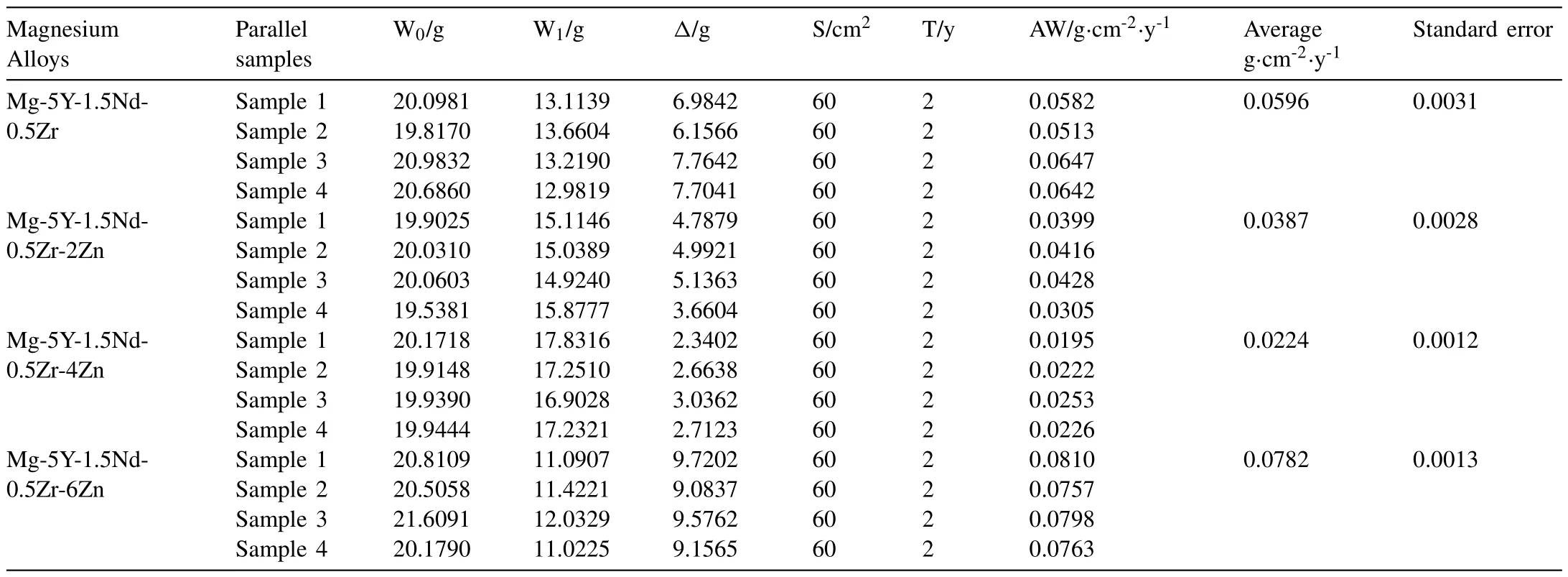
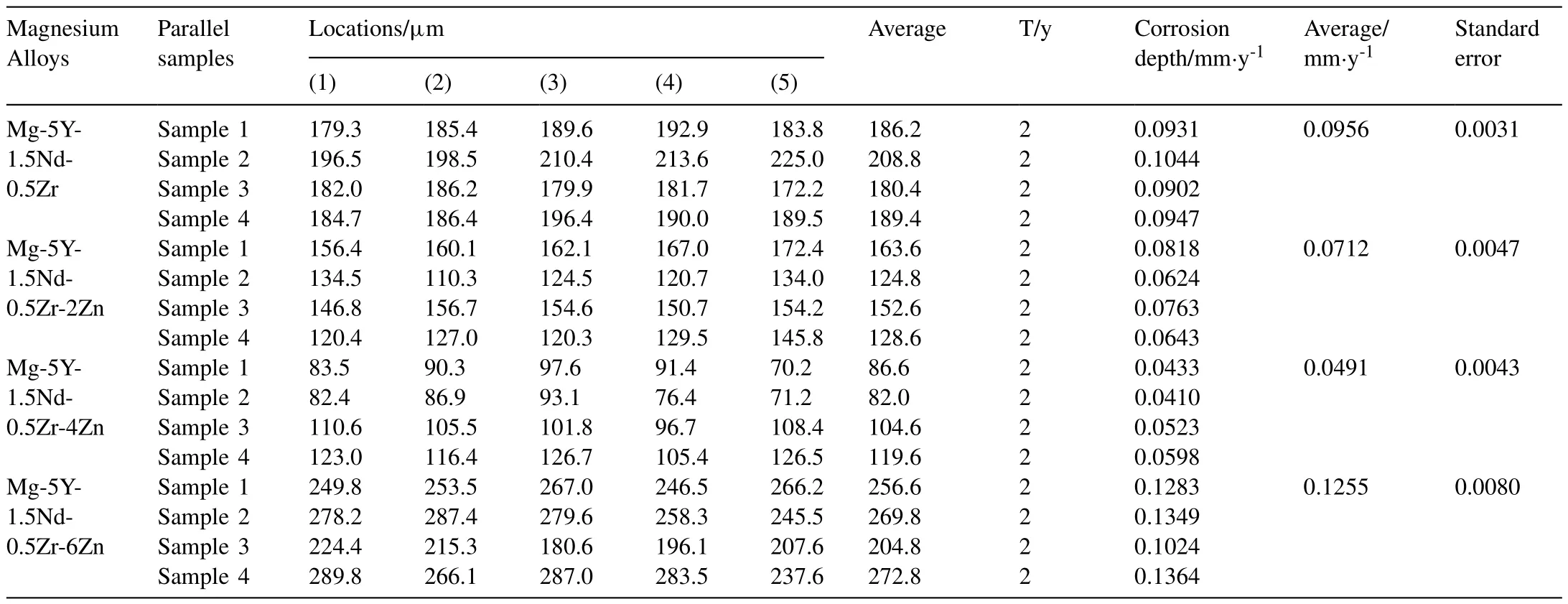
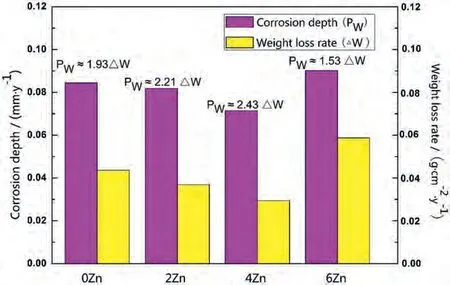
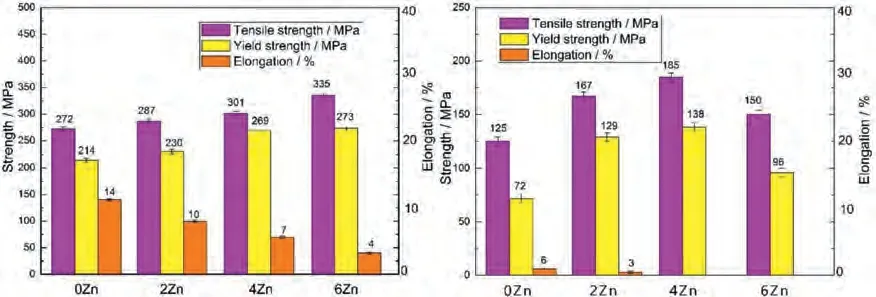

3.3. Corrosion in KEXUE vessel atmospheric marine environment


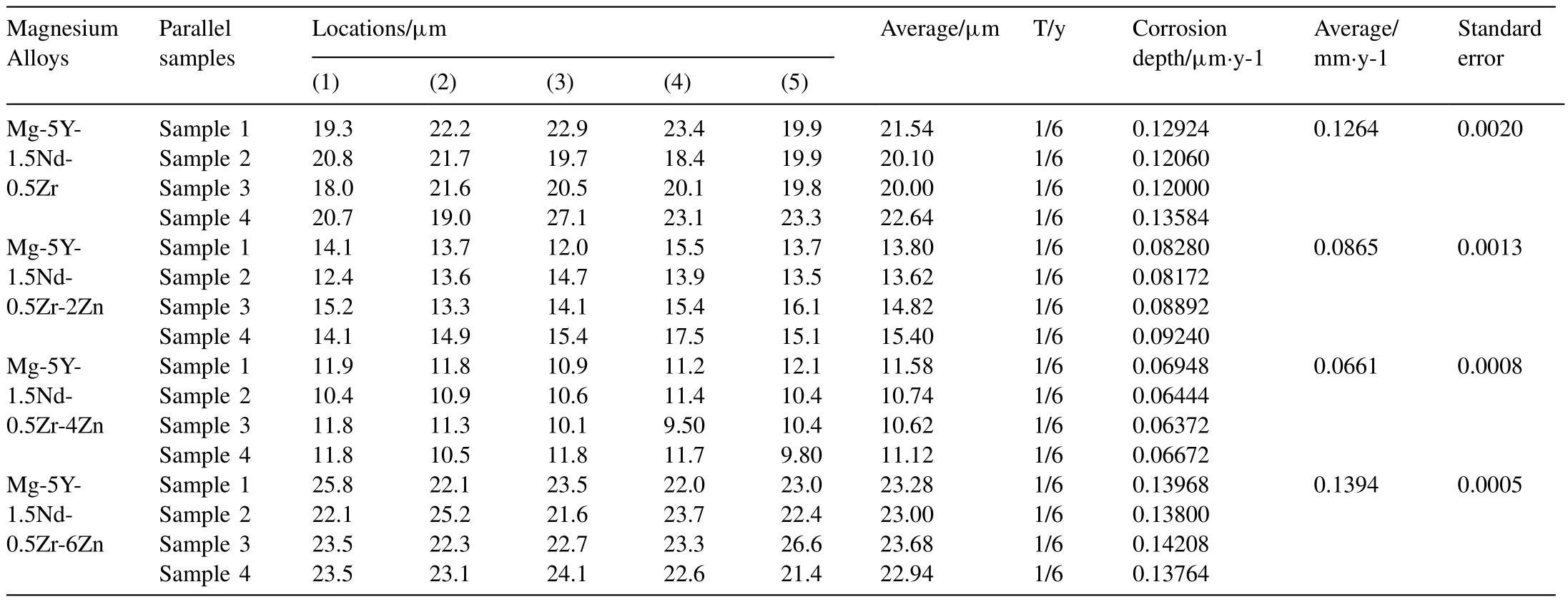
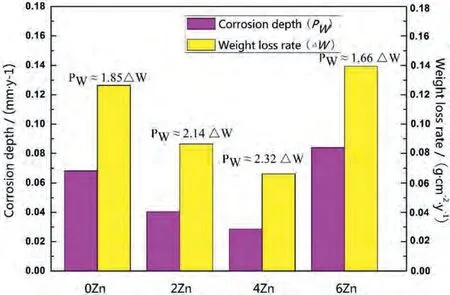

3.4. Electrochemical corrosion in natural sea water
3.5. The effect of precipitated phases on corrosion behavior
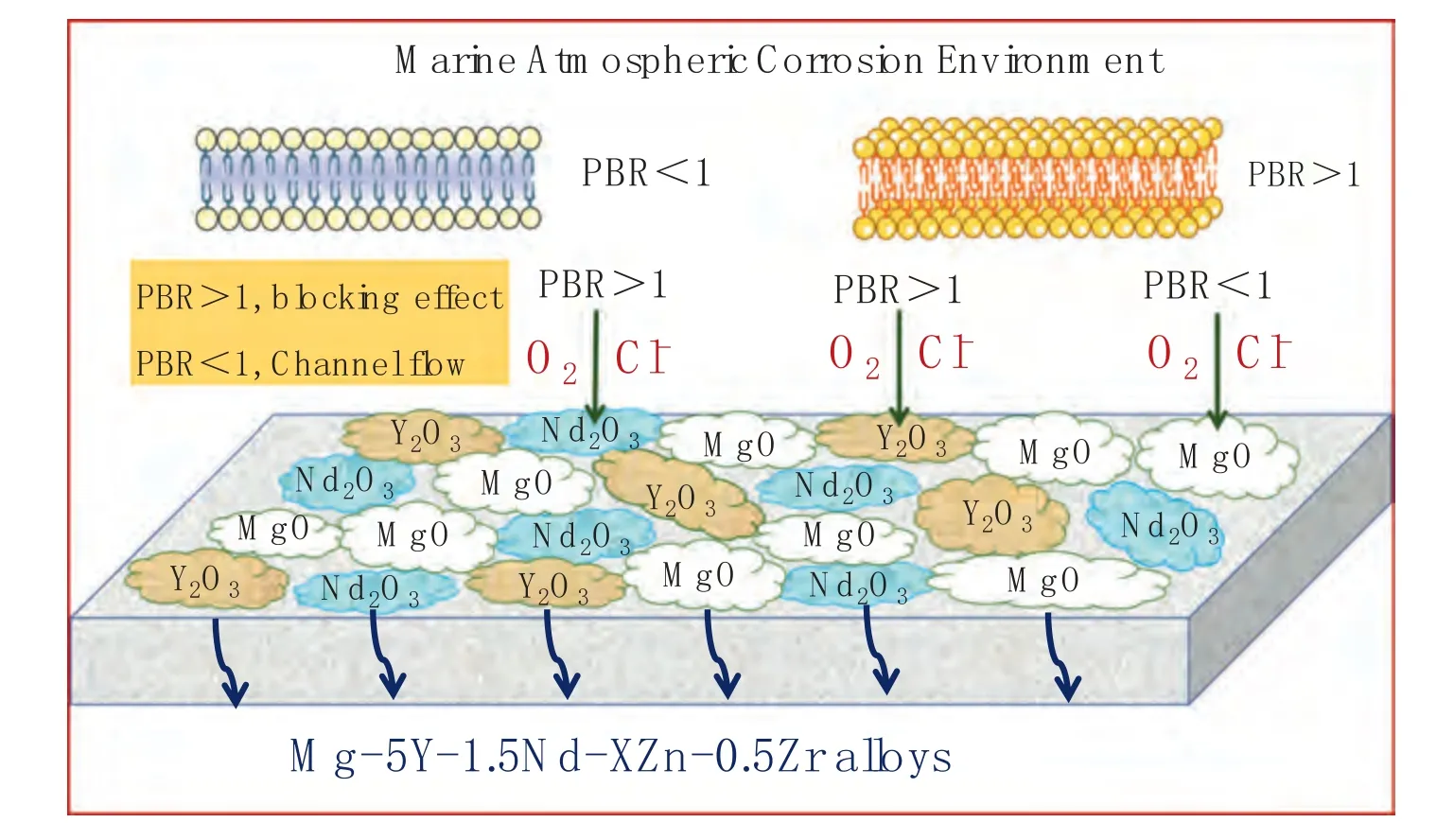
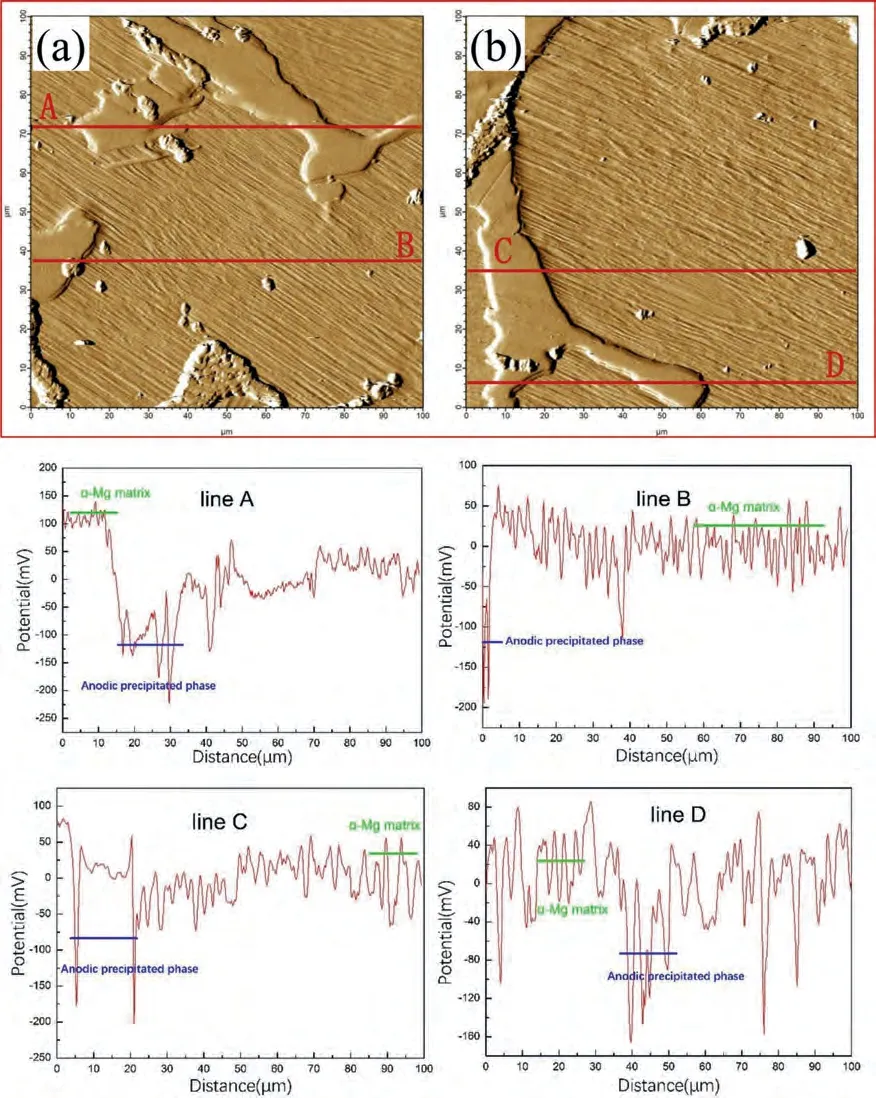
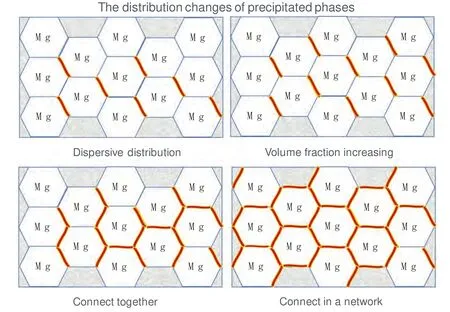
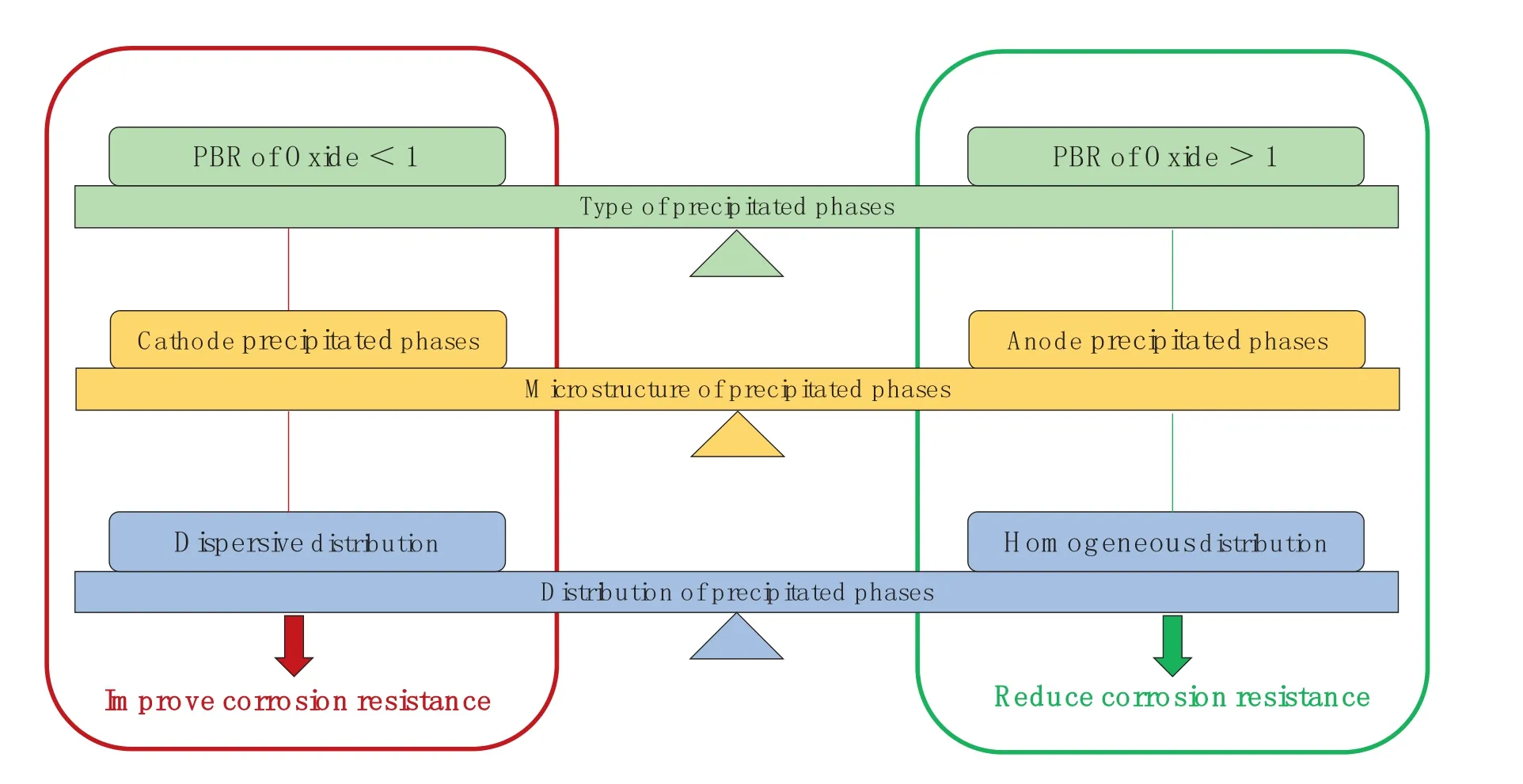
4.Conclusion
杂志排行
Journal of Magnesium and Alloys的其它文章
- Graphene–calcium carbonate coating to improve the degradation resistance and mechanical integrity of a biodegradable implant
- Degradable magnesium alloy suture promotes fibrocartilaginous interface regeneration in a rat rotator cuff transosseous repair model
- Stress-corrosion coupled damage localization induced by secondary phases in bio-degradable Mg alloys: phase-field modeling
- HVOF-sprayed HAp/S53P4 BG composite coatings on an AZ31 alloy for potential applications in temporary implants
- Greatly enhanced corrosion/wear resistances of epoxy coating for Mg alloy through a synergistic effect between functionalized graphene and insulated blocking layer
- Superplasticity of fine-grained Mg-10Li alloy prepared by severe plastic deformation and understanding its deformation mechanisms
